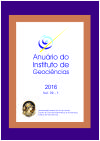Tafonomia dos Invertebrados do Sítio Canastra, Formação Romualdo, Cretáceo Inferior, Bacia do Araripe, Araripina, Pernambuco, Brasil
DOI:
https://doi.org/10.11137/2016_2_77_87Keywords:
Taphofacies, Mollusks, Echinoids, Marine transgression, Storms.Abstract
The Romualdo Formation, Araripe Basin, corresponds to sedimentary rocks of shallow marine to transitional environment deposited during the late Aptian-early Albian. In the Sítio Canastra section, municipality of Araripina, Pernambuco State, are observed mudstones grading to calcarenites at the base of the outcrop. Calcareous nodules bearing fossil fishes are frequently found in the mudstones. The paleoenvironment is interpreted as transitional with fluctuating energy, suggesting successive transgression cycles. Towards the top the section, there are calcareous sandstones with fossils molluscs and echinoids, allowing the stablishment of different taphofacies, supporting the paleoenvironmental interpretation of the area. Through the taphonomic analysis, three taphofacies (T.I, T.II, T.III) were identified. The presence of marine organisms in the taphofacies, such as the echinoids of the species Pygurus tinocoi and Bothryopneustes araripensis in association cassiopid gastropods and mitilid bivalves, suggest a deposition in a of the species marine environment. Well preserves articulated equinoid shells ocurring in association to articulated and closed bivalves in T.I indicate a mostly biogenic living community generated by obrution deposits. In T.II and T.III, fragmentation is frequent, with bioclasts of several sizes. The fossil concentrations are poorly sorted with complex and chaotic packing, both in plant and vertical section, the above features are typical of tempestitic events in proximal areas. We concluded that the Canastra fossil site, represents the evolution of the Araripe paleolagoon, with an initial transgression gradating to a shallow marine environment with transport and burial of macrobenthic organisms between the beach and the platform (Araripina), through the action of storms, in agreement with data obtained in other areas of the basin.Downloads
Download data is not yet available.
Downloads
Published
2016-06-23
How to Cite
Ludmila, P. A. C. do (2016) “Tafonomia dos Invertebrados do Sítio Canastra, Formação Romualdo, Cretáceo Inferior, Bacia do Araripe, Araripina, Pernambuco, Brasil”, Anuário do Instituto de Geociências. Rio de Janeiro, BR, 39(2), pp. 77–87. doi: 10.11137/2016_2_77_87.
Issue
Section
não definida
License
This journal is licensed under a Creative Commons — Attribution 4.0 International — CC BY 4.0, which permits use, distribution and reproduction in any medium, provided the original work is properly cited.















